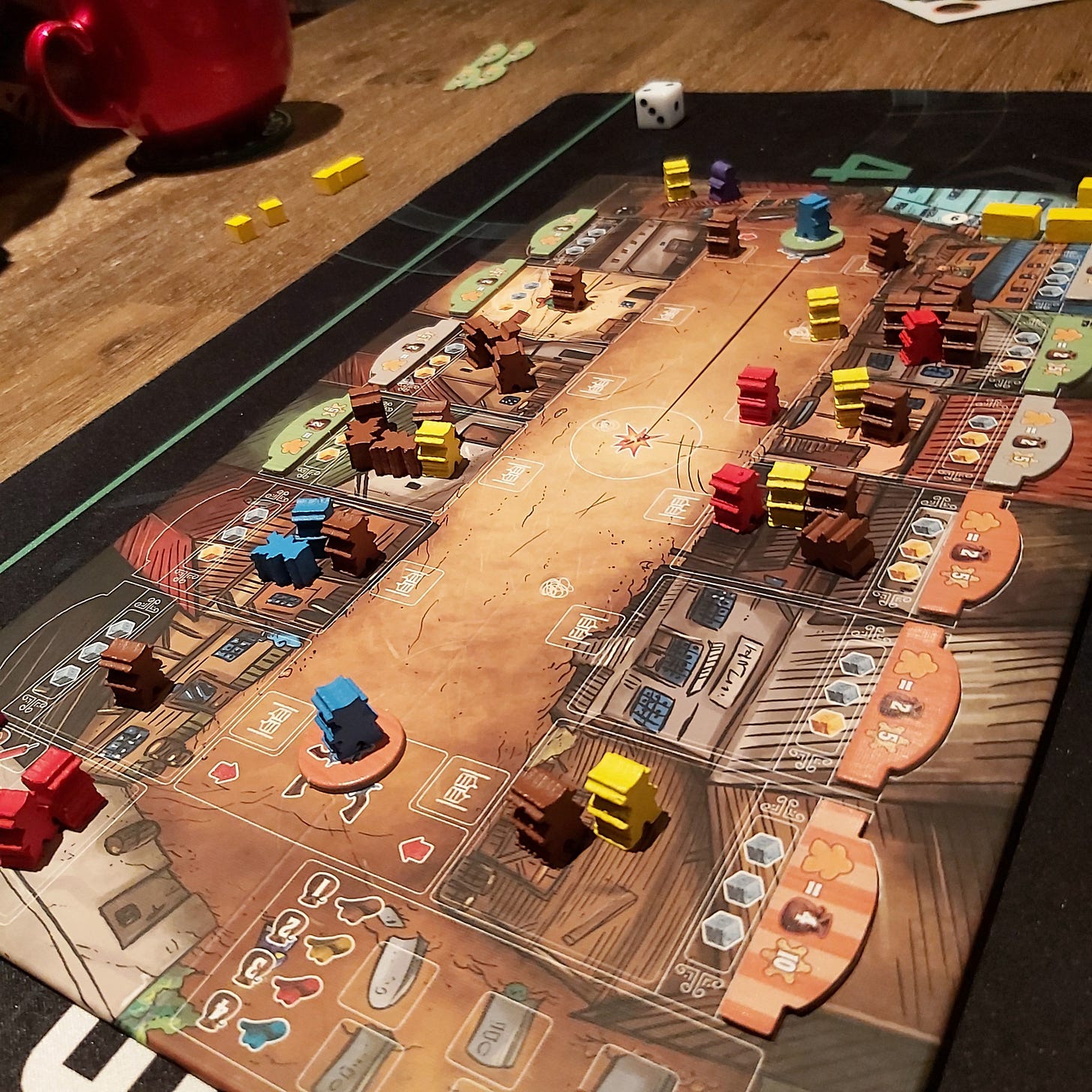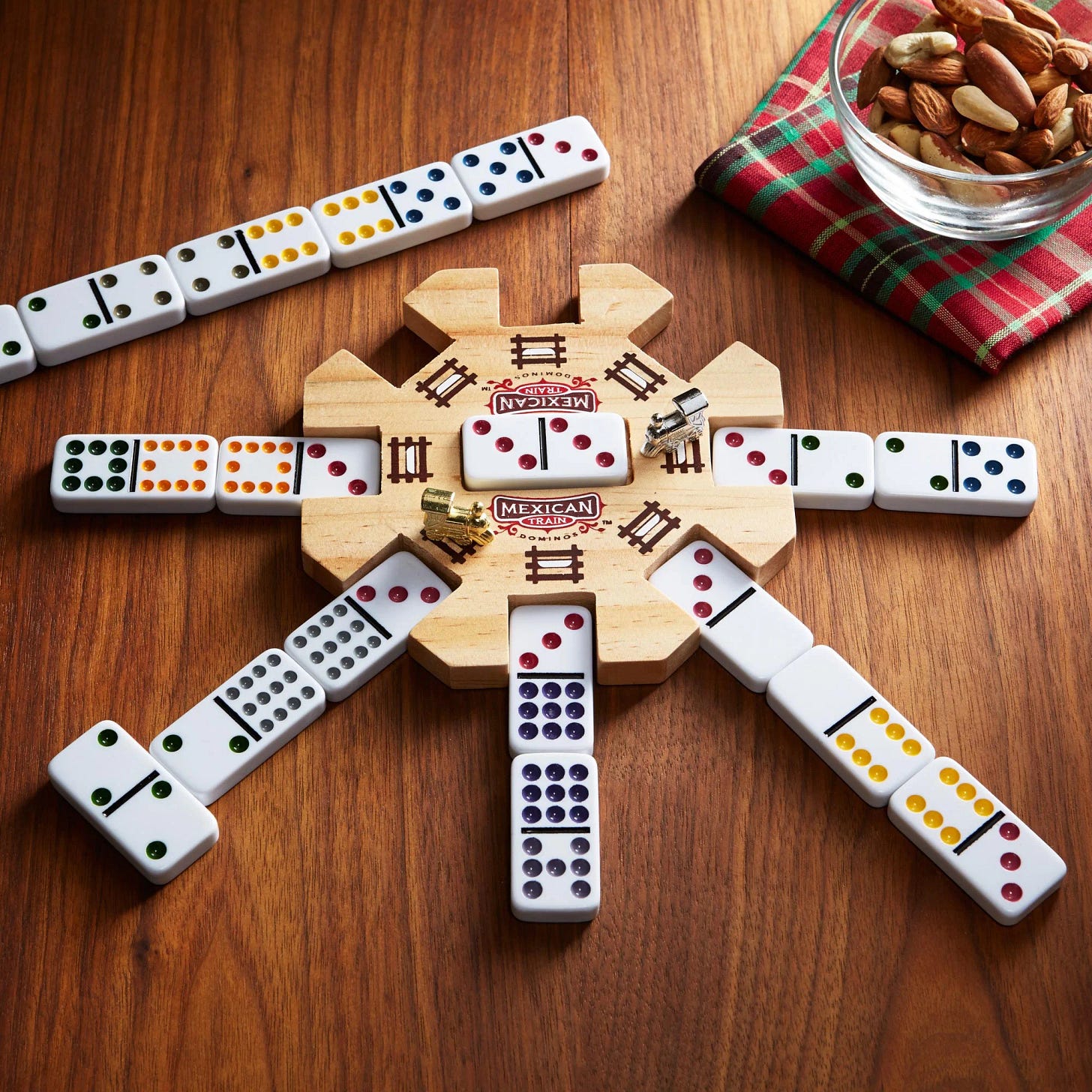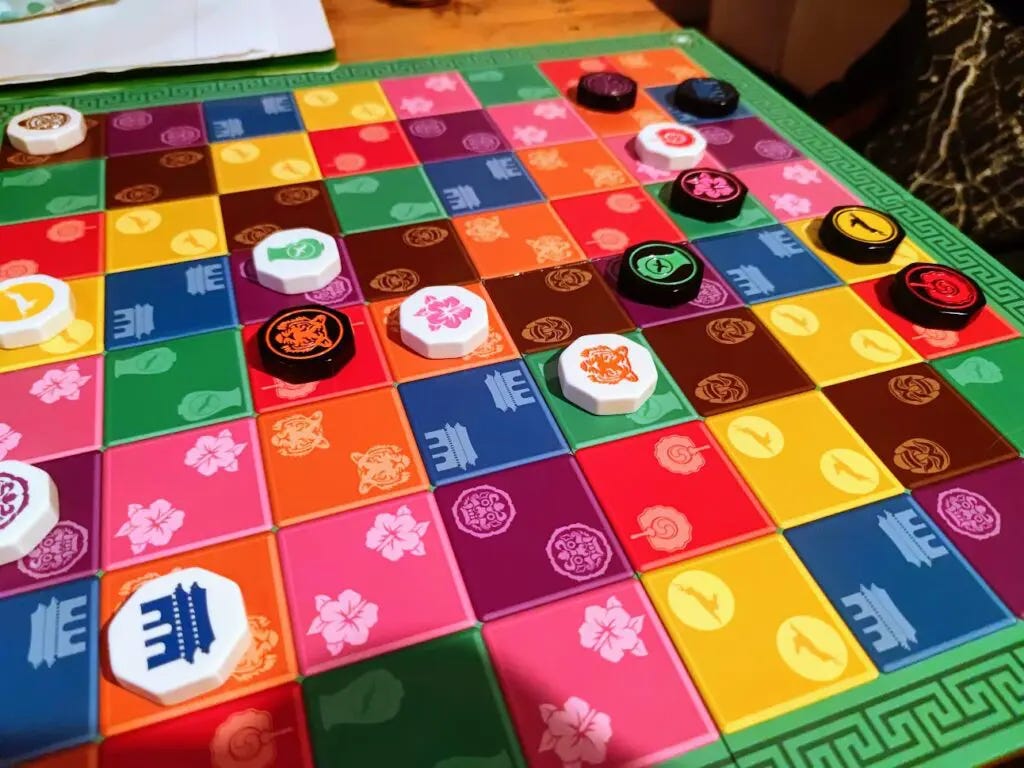Traditional Games - They're Way More Awesome Than You Think
There's a reason modern games keep 'borrowing' them. Let's take a look at the games we play and the games they're built on.
I don’t know what it’s like nowadays, but back when I was a kid quite a few years ago, if you went to your grandparents’ house, your options for entertainment were limited. You wouldn’t find a shiny copy of Torpedo Run or Ghost Castle on their shelves. You were more likely to find a set of dominoes, a pack of cards, or maybe a chess or draughts/checkers board if you were lucky. At the time, it might have seemed like slim pickings, but now that you’re skittering down the tabletop games rabbit hole, it might be time to look back on those old games like Robert Redford does in Jeremiah Johnson.
You see, those very same ‘boring games’ are the bedrock that many of today’s most popular games are built on. Some are a few layers of abstraction deep, while some are openly designed in homage to their ancestor. Let’s take a look at a few.
Kalah / Mancala
More commonly known as Mancala, Kalah has been played for hundreds of years. Its BGG entry lists it as being from around 700 AD, but it’s likely that variations were being played hundreds of years before that. The basic idea is that each player has a series of holes/pits/buckets in front of them with a number of objects in each. Seeds, marbles, nuts, ball bearings - it doesn’t matter what they are. On your turn, you choose one of the pits, pick up everything in it, and distribute them in the subsequent adjacent pits.
If you’ve never played, I urge you to try. You can buy boards pretty cheaply, but all you need in reality is some dirt, a stick to mark the pits, and some seeds or beans for playing pieces. As it just so happens, I wrote a popular guide for how to play Mancala, which you can read right here - How to play Mancala. Once you start playing, it’s very easy to get drawn in, and given how quick and easy it is to play, the ‘one more game’ power it possesses is very strong.
Of course, the point of this piece is to show how these games have influenced the hobby since, and Mancala’s fingerprints are easy to find.
A Fistful of Meeples (Jonny Pac, 2019) is one of my favourites. Instead of seeds and pits, you’re picking up little cowboy meeples and distributing them around a western town. Mining for gold, jailbreaks, and even duels on the main street. It’s cheap, charming and a lot of fun.
Five Tribes (Bruno Cathala, 2014) is a game set in Arabia which has you picking up groups of coloured meeples, distributing them over adjacent tiles, and taking actions and bonuses based on the last meeple that gets placed. It’s a bit like the way if you put your last seed in an empty pit opposite your opponent’s seeds in Mancala, you claim those seeds as your own. There are more layers in Five Tribes, with area control and turn order bidding, but the core underlying mechanism is unashamedly Mancala. It’s a fantastic game, too.
Crusaders: Thy Will Be Done (Seth Jaffee, 2018) is another great example, especially because it also includes one of my favourite mechanisms - a rondel. You could argue that Mancala is a lot like a rondel anyway, but it’s blatant in Crusaders. Each player has an action wheel (rondel) where tokens are placed. The number of tokens on an action determines its strength, and when you take that action, the tokens are then distributed, Mancala-style, to the subsequent sections of the wheel. It’s a great, tight area control game.
Honourable mentions have to go to Finca (fruit harvesting in Majorca, which recently got reprinted), Trajan (Stefan Feld’s Roman masterpiece), and Istanbul (get your assistants working for you in the grand bazaar).
Dominoes
People of my age might remember Domino Rally, which was a home version of those giant domino-toppling events you’d see on TV. Why don’t you see those any more? Dominoes as a tabletop game, is much older. Chinese dominoes were often used in the place of playing cards, and while there’s no confirmed link between the two, western dominoes came along and had very different markings and uses, and eventually migrated out from Europe to the Caribbean, and beyond.
If we take a step away from the East Asian games that use GuPai tiles (Mahjong tiles are not dominoes), because those were mostly variants of playing card games, we’re left with the tile-laying and matching fun. You can probably see where I’m going with this.
Mexican Train (c. 1860) is one of the games which uses something close to a traditional numbered set of dominoes. Despite having rules copyrighted by the Parsons in the 1990s, the game existed in Latin America for a long time before. It’s an abstracted game about building trains, but has hints of concepts like line ownership that would later come to games like the 18xx series.
Kingdomino (Bruno Cathala, 2016) is a lightweight game which sees players building a little kingdom on the table in front of them. It borrows heavily from the traditional domino games, as you’re trying to match the landscape types which adorn the tiles instead of a number of pips. Queendomino followed, which is a little more complex, but still follows a similar idea.
Carpe Diem (Stefan Feld, 2018) might not be the first game that springs to mind when you think of dominoes, but this city-building tile-layer has it running through its DNA. You draft tiles to add to your city, but when it comes to placing the double-ended tiles, you need to match like ends to expand and complete buildings. Sadly, Carpe Diem gets overlooked in favour of Stefan’s other games, but it’s solid and deserves to be played.
Honourable mentions get a little fuzzy, because strictly speaking, you could bundle any tile-layer with an element of matching. For my money, though, you ought to be looking at the likes of Azul, Sprawlopolis, the more recent Akropolis, and even Lords of Vegas at a push.
Chess
Everyone knows Chess. The classic abstract strategy duel. With its roots in the ancient Indian game of Chaturanga, Chess’ influence cannot be overstated. From modern Chess to Shogi, Xiangqi and beyond, its influence is felt all over the world, so it makes sense that modern games have taken a leaf from its substantial book.
For this section, I’m focusing on abstract strategy games for two players. Games which build on the feeling of one-on-one competition but without getting too bogged down in theme or window dressing.
Hive (John Yianni, 2001) has been described as ‘Chess without a board’, and it’s easy to see why. I bought this game 16 or 17 years ago and fell in love with the abstract entomological strategy. You lay hexagonal tiles which represent different insects, each of which has its own movement rules. Surround your opponent’s queen and you win, simple as that. Except that it’s anything but simple. There are lots of versions available, including small travel sets that are perfect for beer gardens in the summer.
Kamisado (Peter Burley, 2008) looks more like Chess. Or at least it would, if it weren’t so colourful. It’s an 8x8 grid on a board, and each player has a row of eight castle pieces on their side of the board. The straight line movement rules combined with a clever twist - you have to move your piece, the colour of which matches the square colour the opponent moved to - feels simultaneously simple and deep.
The Duke (Jeremy Holcomb, Stephen McLaughlin, 2013) doesn’t get much airtime in board game media, but it ought to. It’s a clever strategy game where each player has double-sided tiles representing their ranks. The tiles show how you can move and attack. After completing its move, the tile is flipped so offensive units become defensive and vice versa.
Honourable mentions here could go on and on. Onitama, with its 5x5 grid, is an obvious choice. War Chest from the minds behind the Undaunted games also fits the bill, and I think I’d go as far as YINSH and the other games in the GIPF series.
Card games
Bit of a catch-all heading for this section, but that’s just because the traditional card games are so diverse. I’m talking about games like Blackjack, Poker, Whist, Rummy, and Bridge. The games your parents and grandparents would play. This section is a bit nebulous because different decks of cards and the games that came with them sprang up in all corners of the world.
We in the UK and our neighbours across the Atlantic will be most familiar with the four-suited, 52-card deck that most casino games are played with, but in mainland Europe, the emergence of Tarot decks in the 15th Century had a profound impact. Here’s an interesting tidbit: those early decks were known as trionfi, which translates to triumph, giving us the root of ‘Trump’.
Lost Cities (Reiner Knizia, 1999) is the first game that I think of when it comes to set collection, a la Rummy. The game sees two players looking to build increasing runs of cards in five different colours. Five between two doesn’t go nicely, right? And that’s where the fun comes. The gamble of “Do I start another colour now?” is so enticing. It’s a modern classic and some of Dr Knizia’s finest work.
The Crew: The Quest for Planet Nine (Thomas Sing, 2019) is the first recent game I think of when it comes to trick-taking along the lines of Bridge, although different. It’s a really clever co-operative trick-taker with increasingly difficult missions to work through, all done with limited communication. It’s already spawned a sequel set underwater, and plenty of other designers have obviously taken notice.
Incan Gold / Diamant (Bruno Faidutti, Alan R. Moon, 2005) might not have obvious traditional roots at first, but it’s a fantastic, easy-to-learn example of pushing your luck, something best experienced in a casino setting as Blackjack. Push your luck is all over the hobby, perhaps most famously in Sid Sackson’s Can’t Stop, but Diamant is the best card-based example for me.
Honourable mentions could fill another thousand words. The Gang is a very recent co-op game based on Poker, while trick-takers have never been more popular, ranging from fairly standard games like Aurum, through to the quantum shenanigans of Cat in the Box. All variations on a theme, but all with their roots in games like Bridge. Arboretum is a great example of a Rummy-type game with a spatial twist that’s also worth your time. If you expand your search to include non-card-based games, the choice is vast.
New games have not ‘killed’ the originals
A big part of what I wanted to communicate with this post is that, despite traditional games so clearly having influenced modern games, it doesn’t mean that those games have been superseded. They aren’t dead, they haven’t been replaced. They’re still out there and still being played, avidly in many cases. If you’ve fallen in love with modern board and card games, but are under the impression that the best way to enjoy the hobby is to throw money at the latest Vital Lacerda game, or the latest CMON box full of plastic, you’re wrong.
I strongly urge you to learn the traditional games and give them a chance. You can play any of them on your phone for free, so there’s really no excuse not to. If you enjoy them, invest in some nice physical copies too. Here are my recommendations.
Cribbage
Cribbage is unlike any game I’ve played. At its core, it’s a climbing game, but the clever way you use playing cards to try to make 15, 31, pairs, runs etc., and the way you alternate scoring the cards that are put in the crib each round really make it stand out for me. There are a few odd rules for scoring points, but on the whole, it’s a really enjoyable game. You can play variations for more people, but it really shines at two players, and you can get some beautiful pegging boards.
Cribbage is a game which, due to the extra little rules I mentioned above, may be played by slightly different rules depending on who you play with. It’s a result of the game being spread so far and through different languages over the years. A great example is the starter card. At the start of a round, the top card of the deck is flipped - the starter. If this card is a Jack, the player who flipped it scores two points for ‘his heels’. However, I’ve played it with people who call it ‘his nobs’ and ‘his nibs’. I played with one person who only scored the points if the Jack is black.
All of which is great, until you realise that some of those people were wrong, and even then it’s two different rules getting confused. His heels should score two for flipping a Jack as the starter, but ‘his nobs’ or even just ‘nobs’ is when you hold the Jack of the starter suit, and it only scores you a point. Confused yet? Don’t worry, even with some dubious house rules, Cribbage is great. Head over to this site for some really comprehensive Cribbage rules.
Realistically, you only need a deck of standard playing cards to play cribbage, and some way to track score, but to get the authentic experience, you really ought to get a cribbage board. Only then can you truly experience the pain of the stinkhole. Yes, I’m serious. Stinkhole.
Mancala
I mentioned it above, and it’s worth repeating. Mancala is so simple to understand and to teach that you can play with just about anyone. There are so many different custom boards, from clever folding ones to nice, one-piece wooden ones with glass beads, like mine here.
Mancala’s magic comes in how quickly it grabs you. I can honestly say that, without exception, every person I’ve taught it to, from my (then) eight-year-old son through to my dad in his seventies, has really enjoyed it and always wants one more game. It’s a simple, engaging battle of wits.
There’s no denying that if you want an event game for a game night, you’d be better off picking something like Five Tribes, but Mancala boils the mechanism down to its essence. Three games in twenty minutes, easy. There’s something wonderfully tactile about dropping tokens into little pots, you’ve really got to experience it for yourself. I’m going to toot my own horn here again and recommend my own how to play Mancala guide. There’s a reason it has over 200k reads already.
Backgammon
Even if you’ve never played Backgammon before, I bet you could describe the board to me and what appears to be going on. The players sit on opposite sides of a board which has alternating dark and light triangles on it, each with lines of counters on them. They roll dice and move the counters in accordance with some ancient, esoteric rite until one declares themself the winner. At least, that’s how it always looked before I learned to play.
The reality… isn’t too far from that. It’s a game where you’re trying to move all of your counters around the board, back to your home area, before moving them off the board. First to do it, wins. The strategy comes in how you move the pieces. You can move to an empty space, to join a pre-existing stack of your own colour, or to a space where a single opposition counter is, capturing it and sending it off the board, leaving it to re-enter and to make its merry way back around. Setting up ‘primes’ to block unlucky rolls is key.
When you learn Backgammon, you’ll probably go through stages. You start with ‘this is fun’, advance to ‘I still like it, but I don’t see how there’s any strategy’, before finding ‘Ah, now I get it’. Everyone’s favourite Canadian, Rodney Smith, has a great tutorial video. Get yourself a Turkish coffee, set up a table outside in the sun, and pretend you’re living it up in the Mediterranean.
Go
It would have been too easy for me to just add Chess here, so instead I’ve opted for Go. Go is not common in the West, but I wish it were. It’s about as abstract as an area control game could be, and it just works.
Have you ever played the old arcade game Qix, or one of its copycat clones? The idea of that game is to capture pieces of the screen by drawing lines around sections of it. Go works on a similar principle. The aim of the game is to capture as much board territory as possible by fencing sections off with lines of your stones, while stopping your opponent from doing the same thing.
The simplistic rules, especially compared to Chess, make it much easier to learn. On your turn, you place one of your stones on any intersection of two lines of the board. That’s it. Placed stones never move. They can be captured by surrounding them, but Go isn’t a game about moving around the board to dominate. It’s about strategically trying to annexe parts of the board while not being too obvious about it, and trying to stop the other player from doing the same thing.
My favourite thing about teaching and learning Go is that the game is scalable. The 19x19 standard board is daunting to newbies, so instead, you can start on a 9x9 board and play a full game with the same rules in a few minutes. Once you’re comfortable with that, you can move up to a 13x13 board before finally graduating to the full-size board.
Go is ancient, but brilliant. There’s an almost limitless set of resources out there now, thanks to the internet, but I recommend heading to Vadim’s channel, Go Magic, to learn the basics.
Go and play something old
This post could get exhaustively big. Like, book big. I think I’ve made my point, though. Traditional games, like knotweed, have their tendrils wrapped around huge parts of modern gaming. The important takeaway here, if any, is that these older games aren’t defunct just because newer games share their DNA. Chess is still Chess. Euchre is still Euchre. People still play these games in huge numbers because these games are good. Better than good, they’re amazing.
Go and look at your board game shelves. You have an embarrassment of riches. Lavish artwork, beautifully crafted pieces, hulking boxes filled with the promise of joy. How many of them have you played a hundred times? Fifty? Ten? Twice? People who play traditional games play until those numbers are in the hundreds, or even thousands.
If you find yourself hankering for something new because Agricola: Zombie Edition (I wish I were joking) isn’t doing it for you, think about spending the money on a decent deck of cards, a Cribbage set, or a Go board. Spend less time poring over 100-page rulebooks for gargantuan dungeon crawlers, and spend an hour learning a game your grandparents would have played. You’ll be pleasantly surprised.
If you want to do some further reading about the origins of the games we play today, I highly recommend checking out Tim Clare’s book, The Game Changers. I feel no shame in saying it was the inspiration to finally get off my backside and write this.
This is the part where I turn things over to you. Which are your favourite traditional games that I’ve completely ignored? What are your favourite examples of modern games with obvious influence from traditional games? Please let me know below.











I will list "Crokinole," the ancient king of dexterity games.
Not that it's really ancient. But it's more than fifty years old, which is ancient by modern board gaming standards.
“For the Crown” in 2022 from VPG was an interesting riff on chess.